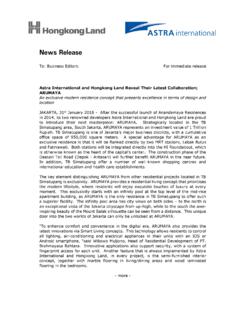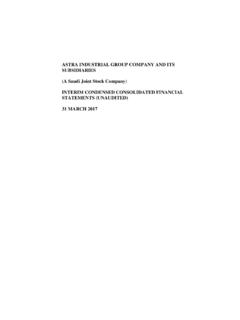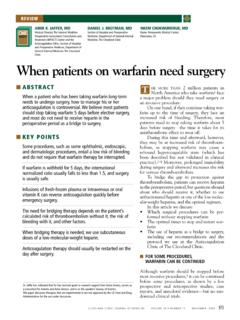Transcription of The ASTRA Complex
1 The ` ASTRA ` National Museum ComplexLocated in the center of Romania, The ` ASTRA ` National Museum Complex is the most important ethno-museum institution in Romania. It was created under the auspices of the Transylvanian Association for Romanian Literature and which was an institution founded in 1861. The ` ASTRA ` Museum formerly known as the Association Museum - opened its first exhibition on the 19th of August, 1905. The museum was founded out of the Transylvanian people`s desire to define their own ethno-cultural identity within the Austro-Hungarian Empire multiculturalism and having as background the cultural emancipation of all peoples from the centre and south-east of under this structure after 1990, the ` ASTRA ` National Museum Complex has four museum units of ethnographic profile in its structure and a department of anthropological documentary film which are sustained by the following departments.
2 The Conservation and Restoration Department, the Educational Department, the Cultural Marketing Department, the Tourist Information Centre, the ` ASTRA Museum` Publishing House and the Project Management of the Romanian PeopleThe most important museum unit is THE ` ASTRA ` MUSEUM OF TRADITIONAL FOLK CIVILIZATION or THE OPEN AIR MUSEUM. Situated in the natural reservation of Dumbrava Sibiului, on the road to Rasinari village and to Paltinis ski resort, 8 kilometers away from the city centre, the Open Air Museum spreads across a 96 ha area of which an area of 40 ha is covered by the permanent exhibition which is the largest open air ethnographic exhibition in in 1963 under the name of the Museum of Folk Technics, the museum currently has over 400 monuments of folk architecture and technique as well as an impressive collection of ethnographic heritage objects.
3 The collection of mills, the wooden churches, and the traditional homesteads are very popular and very much appreciated. The museum is divided in 6 thematic sectors, 36 thematic groups and as a living museum, it hosts many traditional events such as: traditional fairs, folk festivals, workshops, performances and much more. The traditional function is kept for the wooden churches where all religious ceremonies specific to Romanian tradition are regularly performed. The exceptional natural landscape makes the open air museum adequate during both summer and winter, for educational visits, relaxing walks, drives by carriage, sleigh or sailing, according to everyone`s museum has its own traditional inns, spaces suitable for practical lessons, a lake, a playground, over 400 parking lots and over 10 kilometers of paved alleys.
4 THE ` ASTRA ` MUSEUM OF TRADITIONAL FOLK CIVILIZATION hosts workshops, handicraft trainings, team buildings, and other recreational activities. The traditional Romanian village reveals the visitor its heritage richness specific to all the ethnographical areas of Romania. Cultural events are organized during the summer `Franz Binder` Museum of Universal Ethnography is located in 11 Small Square, in a historical building, erected between 1865 and 1867, as residence for the Association of Small Craftsmen. Inaugurated at 18 May 1993, it is the first and the only museum in Romania until now with the purpose to present the public various aspects belonging to the world peoples` culture, civilization and art based on its own collections and through collaborations.
5 Inside the ` ASTRA ` ethno-museum Complex , the `Franz Binder` museum introduces moreover the perspective of the non-European as a knowing alternative and a comparative explaining of the `difference` as an element of cultural are two important stages for the formation and development of the ethnographic heritage at the `Franz Binder` Museum: the second half of the 19th century and the period after 1990. Thus the collection of `exotic` ethnography, formed by means of donations made to the Transylvanian Association for Natural Sciences by Saxon travelers and naturalists on other continents , mirrors the journey as form of knowledge and the birth of ethnology as science.
6 They preceded the ethnologists and often obtained amazing results by replacing the academic formation with an ever renewed founder of the extra - European ethnographic collections from Sibiu - and the one the museum was named after - is Franz Binder (1824-1875), a merchant and a passionate explorer, consul of the Austrian Empire in the Turkish-Egyptian Sudan. In 1862, Franz Binder donates to the Transylvanian Association of Natural Sciences from Sibiu and to the Evangelical Gymnasium from Sebe , his native town, his collection of African objects (the collections count more than 500 pieces) originated mainly from the South of Sudan, from the tribes in Bhar al-Ghazal region, on the upper course of the White Nile.
7 `Franz Binder` collection is one of the oldest and richest collection in the word today containing objects from the Southern Sudan: there is only the collection from Venice donated by Giovanni Miani which outnumbers the artifacts from the collection in donation made by Hermann von Hannenheim is of great impact. He donated in 1907 an Egyptian mummy in its wooden sarcophagus dating from the late Ptolemaic Period (more than 2000 years old), which comes from Gamhud, an archeological site on the left bank of the `Franz Binder` Museum doubles its heritage collections by means of donations, collection exchanges and acquisitions after the following appear : the Congolese collection Violeta i C t lin Rang; the collection of costumes of the national minorities in China, a donation of the Embassy of China in Romania.
8 The collection of non-European handicraft, a governmental allocation from the ex protocol presents from 1965-1989 (following the allocations made by the government from 1991 and 1999; ethnographic objects from Japan (exchanges of collections) traditional toys from the Toys Japanese Museum near Himeji and kimonos, ceramics, temari balls, vegetable fibers woven handicrafts, wooden toys, textiles etc. from the Shimane Transylvania Association; the handicraft collection donated by the diplomatic representatives in Bucharest of the Republic of Ecuador; a Guarani handicraft donation brought from Argentina; the collections of Indonesian ethnography and folk art donated by the Embassy of the Republic of Indonesia and by the anthropologist Kate Kerr; the collection of the Indian ethnographic dolls, a donation from the Indian Council for the Cultural Relations from New Delhi; Mayaya & Hliban collection with traditional textiles, little ritual statues, contemporary handicraft objects and photos from the Sub-Saharan Africa.)
9 The donation of photos from Altai and Kamchatka, made by Gabriela Medrea, as well as other numerous artifacts which come from all the ` ASTRA ` Museum of Transylvanian Civilization, founded in 1993, continues in the concept of traditional museum from 1905 when the first national museum of the Romanian people from Transylvania was founded, The Association Museum, founded by the ` ASTRA ` Transylvanian Association for Romanian Literature and Folk Civilization. The ` ASTRA ` Museum of Transylvanian Civilization is the treasurer of the patrimonial assets i nherited from the Association Museum. 9002 objects appear in the inventory register under A category divided in collections: embroidery, folk costumes, religious objects, wood-bone-iron, ceramics and dolls.
10 Over the years, these heritage values were presented in various exhibitions organized both in our country as well as ` ASTRA ` Museum of Transylvanian Civilization is conceived as a pluri-ethnic and interdisciplinary museum, its main goal being to define the multiculturalism of a European region with a pluri-ethnic, multisecular coexistence, as well as to highlight these European values a nd ethnic community in present, because of the lack of an appropriate space for a permanent exhibition, its rich heritage, containing cultural objects, is in its most part, withdrawn in storages. The ` ASTRA ` Museum of Transylvanian Civilization is still organizing temporary exhibitions in the halls of the Hermes House and the House of Arts.







